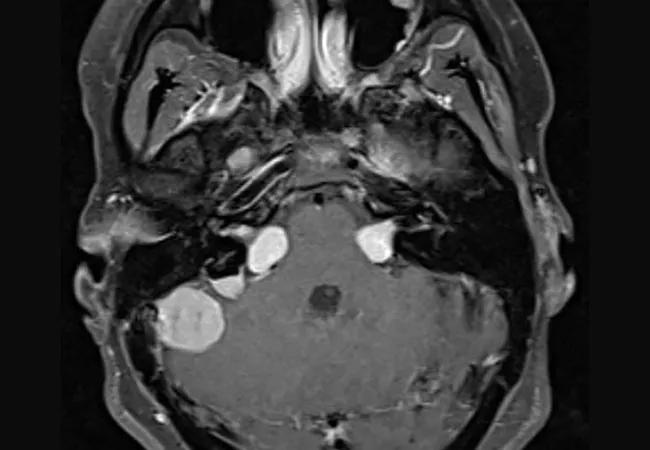Younger patients and those with peritumoral brain edema warrant closer follow-up, earlier treatment

While most meningiomas associated with neurofibromatosis-2 (NF2) grow slowly or not at all within the first years after diagnosis, growth patterns vary markedly, with younger age and the presence of peritumoral brain edema being predictors of growth.
Advertisement
Cleveland Clinic is a non-profit academic medical center. Advertising on our site helps support our mission. We do not endorse non-Cleveland Clinic products or services. Policy
So finds one of the largest single-institution series to date designed to characterize NF2-associated meningiomas and help determine a safe monitoring strategy. The descriptive retrospective study of 137 meningiomas in 48 patients with NF2 identified from Cleveland Clinic electronic medical records was published online in Neurosurgical Focus.
“As we suspected, many meningiomas can safely be monitored without need for treatment,” says the study’s senior author, Pablo Recinos, MD, a neurosurgeon in Cleveland Clinic’s Neurological Institute. “However, we identified younger age and presence of peritumoral brain edema as risk factors for growth.”
Meningiomas, the second most common tumor associated with NF2 (after schwannomas), contribute significantly to disease morbidity and risk of death. Multiple meningiomas can be diagnosed in a single patient at the same time, posing a particular conundrum for neurosurgeons as they must determine which tumor, if any, may be causing symptoms and then develop a management strategy.
“Patients often are told they need surgery because they have a meningioma,” says Dr. Recinos, “but in our experience, this is not always the case.”
This study is the first series to use volumetric analysis of the entire neuroaxis to assess NF2-associated meningiomas. The authors note that using three-dimensional imaging to monitor tumor growth is important, as linear measurements alone may not reveal volumetric increases and are more subject to reader variation.
The study included 137 meningiomas from 48 patients with NF2 who were seen at Cleveland Clinic between 2000 and 2019. Mean age was 39.5 years at initial imaging, and median follow-up was 32 months (interquartile range: 10.9, 68.3). The average number of tumors per patient was 2.8, with 72.3% of all tumors in female patients. The most common tumor locations were the cerebral convexity (25%), parafalcine region (18%) and spine (10%).
Advertisement
Advanced radiographic analysis of each meningioma was performed. The following tumor characteristics were found:
Major findings related to growth include the following:
Smaller tumor volume at first imaging was also found to predict growth, but the authors urge caution in interpreting this finding. “Large tumors must increase by a much greater volume to meet the growth threshold, so that could account for this finding,” notes co-author Pranay Soni, MD, a PGY7 neurosurgery resident at Cleveland Clinic. “Other published reports correlating tumor growth rate to size have had mixed results.”
Advertisement
During the study period, 31 meningiomas (23%) were treated (20 surgically and 11 with radiation). Of those treated surgically, 15 (75%) were found to be WHO grade I, four (20%) grade II and one (5%) grade III.
No guidelines have been established in North America for following meningiomas, but guidelines from the European Association of Neuro-Oncology recommend annual MRI screening for the first five years in patients without symptoms, although this recommendation is not specific to NF2-associated meningiomas.
Given this study’s identified risk factors for growth — younger patient age and peritumoral brain edema — the authors recommend an initial follow-up monitoring schedule of three to six months in patients with either of these factors.
“When determining the optimal management strategy for each patient, it’s important to consider that neurofibromatosis is a complex condition with multiple factors, including the presence of schwannomas, meningiomas and other tumors,” observes Dr. Soni, who will be joining Cleveland Clinic as a staff neurosurgeon when he completes his residency in summer 2022. His addition to the staff will help expand Cleveland Clinic’s Neurofibromatosis Center, in conjunction with the efforts of neuro-oncologists Neha Patel, MD, and Mina Lobbous, MD.
“A multidisciplinary evaluation to establish the global clinical picture is essential for assessing risk for each patient,” Dr. Soni concludes.
Advertisement
Advertisement

Early results show patients experiencing deep and complete response

Inclusion of genomic profiling and risk factors recommended for treatment planning

Collaborative research effort underscores the urgent need for effective second-line therapies in this rare, aggressive cancer

Largest study to date comparing direct-acting oral anticoagulants to low-molecular-weight heparin

Treatment assigned FDA review date in June 2025

Pembrolizumab does not improve outcomes, but immunotherapy may still offer benefit

Cleveland Clinic, the University of Minnesota and University of Cambridge receive $1M grant to develop point-of-care biosensor for early detection and treatment personalization

Long-acting antiemetics and high-dose steroids key to minimizing acute nausea